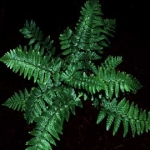| Common Name: |
Male Fern |
| Botanical Name: |
Dryopteris filix-mas syn. Aspidium filix-mas |
| Genus: |
Dryopteris |
| Family: |
Dryopteridaceae |
| Native Location: |
Europe and N America |
| Cultivation: |
Rich soil in shade. Foliage may be affected by rust. |
| Propagation: |
By spores sown when ripe at 15°C (59°F); by division in autumn or spring. Variants do not come true from spores. |
| Harvest: |
Rhizomes are lifted in autumn, leaving bases of fronds but removing roots, and dried for use in liquid extracts and powders. Stocks are renewed annually. |
| Height: |
1m (3ft) |
| Width: |
1m (3ft) |
| Variations: |
Barnesii
Has long narrow fronds
Height: 1.2m (4ft)
Width: 1.2m (4ft)
Crispa Cristata
Is smaller, with crested fronds and leaflets both crisped and crested.
Height 60cm (2ft)
Linearis
Has narrower divisions, giving slender, more graceful fronds. |
| Hardiness: |
Z4-9 |
| Parts Used: |
Rhizomes |
| Properties: |
A bitter, unpleasant-tasting, highly toxic herb that expels intestinal worms and has anti-bacterial and anti-viral effects. It also controls bleeding, relieves pain, reduces inflammation, and lowers fever. |
| Medicinal Uses: |
Internally for all intestinal parasites, liver flukes, internal hemorrhage, uterine bleeding, mumps, and feverish illnesses (including colds, influenza, measles, pneumonia, and meningitis). Doses for intestinal worms are critical; poisoning is prevented by combining with a saline purgative, such as magnesium sulfate, but not with castor oil, which increases absorption. Excess causes nausea and vomiting, delirium, breathing difficulties, blindness, and heart failure. Externally for abscesses, boils, carbuncles, and sores. For use by qualified practioners only. |
| Warning: |
This herb is subject to legal restrictions in some countries. |
| Bibliography: |
Encyclopedia of Herbs by Deni Brown Copyright © 1995, 2001 Dorling Kindersley Limited Pp 197-198 |

